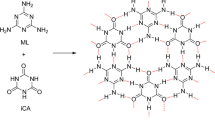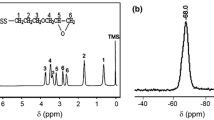Abstract
A reaction between a linear polypropylene functionalized with maleic anhydride (PPg) and epoxy resin (bisphenol A diglycidyl ether) was carried out on the molten state to generate long-chain branches (LCB) in the molecular structure of the PPg. Concentrations of epoxy resin (ER) of up to 3.15 wt% were employed to obtain different levels of branching. FTIR spectroscopy analysis indicates that during the reaction, anhydride groups in PPg are consumed and new ester groups are formed. The presence of branches was verified using multiple-detection size-exclusion chromatography and rheology. The degree of long-chain branching induced in PPg augments with increasing concentration of ER. Furthermore, the materials modified with higher content of ER display gel-like behavior. The long-chain branched polymers also display thermo-rheological complexity. Thermal characterization studies show that LCBs have a nucleating effect during crystallization and cause the augment of the crystallization activation energy of PPg.















Similar content being viewed by others
References
Gahleitner M (2001) Melt rheology of polyolefins. Prog Polym Sci 26:895–944
Han CD (2007) Rheology and Processing of Polymeric Materials, Polymer Rheology, vol 1. Oxford University Press, New York
Utracki LA (2002) Polymer blends handbook, vol 1. Kluwer Academic Publisher, Berlin
Lu B, Chung TC (1999) Synthesis of long chain branched polypropylene with relatively well-defined molecular structure. Macromolecules 32:8678–8680. doi:10.1021/ma991010r
Sugimoto M, Tanaka T, Masubuchi Y, Takimoto JI, Koyama K (1999) Effect of chain structure on the melt rheology of modified polypropylene. J Appl Polym Sci 73:1493–1500. doi:10.1002/(SICI)1097-4628(19990822)73:8<1493:AID-APP18>3.0.CO;2-2
Lagendijk RP, Hogt AH, Buijtenhuijs A, Gotsis AD (2001) Peroxydicarbonate modification of polypropylene and extensional flow properties. Polymer 42:10035–10043. doi:10.1016/S0032-3861(01)00553-5
Rätzsch M, Arnold M, Borsig E, Ra M, Bucka H, Reichelt N (2002) Radical reactions on polypropylene in the solid state. Prog Polym 27:1195–1282. doi:10.1016/S0079-6700(02)00006-0
Graebling D (2002) Synthesis of branched polypropylene by a reactive extrusion process. Macromolecules 35:4602–4610. doi:10.1021/ma0109469
Auhl D, Stange J, Münstedt H, Krause B, Voigt D, Lederer A, Lappan U, Lunkwitz K (2004) Long-chain branched polypropylenes by electron beam irradiation and their rheological properties. Macromolecules 37:9465–9472. doi:10.1021/ma030579w
Auhl D, Stadler FJ, Münstedt H (2012) Comparison of molecular structure and rheological properties of electron-beam- and gamma-irradiated polypropylene. Macromolecules 45:2057–2065. doi:10.1021/ma202265w
Gotsis AD, Zeevenhoven BLF, Hogt AH (2004) The effect of long chain branching on the processability of polypropylene in thermoforming. Polym Eng Sci 44:973–982. doi:10.1002/pen.20089
Paavola S, Saarinen T, Löfgren B, Pitkänen P (2004) Propylene copolymerization with non-conjugated dienes and α-olefins using supported metallocene catalyst. Polymer 45:2099–2110. doi:10.1016/j.polymer.2004.01.053
Ye Z, AlObaidi F, Zhu S (2004) Synthesis and rheological properties of long-chain-branched isotactic polypropylenes prepared by copolymerization of propylene and nonconjugated dienes. Ind Eng Chem Res 43:2860–2870. doi:10.1021/ie0499660
Nam GJ, Yoo JH, Lee JW (2005) Effect of long-chain branches of polypropylene on rheological properties and foam-extrusion performances. J Appl Polym Sci 96:1793–1800. doi:10.1002/app.21619
Krause B, Voigt D, Häußler L, Auhl D, Münstedt H (2006) Characterization of electron beam irradiated polypropylene: influence of irradiation temperature on molecular and rheological properties. J Appl Polym Sci 100:2770–2780. doi:10.1002/app.23453
Tian J, Yu W, Zhou C (2006) The preparation and rheology characterization of long chain branching polypropylene. Polymer 47:7962–7969. doi:10.1016/j.polymer.2006.09.042
Langston JA, Colby RH, Chung TCM, Shimizu F, Suzuki T, Aoki M (2007) Synthesis and characterization of long chain branched isotactic polypropylene via metallocene catalyst and t-reagent. Macromolecules 40:2712–2720. doi:10.1021/ma062111+
Fina A, Tabuani D, Peijs T, Camino G (2009) POSS grafting on PPgMA by one-step reactive blending. Polymer 50:218–226. doi:10.1016/j.polymer.2008.11.002
Li S, Xiao M, Wei D, Xiao H, Hu F, Zheng A (2009) The Melt grafting preparation and rheological characterization of long chain branching polypropylene. Polymer 50:6121–6128. doi:10.1016/j.polymer.2009.10.006
Mabrouk KE, Parent JS, Chaudhary BI, Cong R (2009) Chemical modification of PP architecture: strategies for introducing long-chain branching. Polymer 50:5390–5397. doi:10.1016/j.polymer.2009.09.066
Su F, Huang H (2009) Rheology and thermal behavior of long branching polypropylene prepared by reactive extrusion. J Appl Polym Sci 113:2126–2135. doi:10.1002/app.30061
Guapacha J, Failla MD, Vallés EM, Quinzani LM (2014) Molecular, rheological, and thermal study of long-chain branched polypropylene obtained by esterification of anhydride grafted polypropylene. J Appl Polym Sci 131:40357. doi:10.1002/app.40357
Hingmann R, Marczinke BL (1994) Shear and elongational flow properties of polypropylene melts. J Rheol 38:573–587. doi:10.1122/1.550475
Zhang C, Niu H, Dong JY (2012) Fabrication of long chain branched polypropylene using click chemistry. Polym Bull 68:949–959. doi:10.1007/s00289-011-0588-7
Yoshiga A, Otaguro H, Parra DF, Lima LFCP, Lugao AB (2009) Controlled degradation and crosslinking of polypropylene induced by gamma radiation and acetylene. Polym Bull 63:397–409. doi:10.1007/s00289-009-0102-7
Oliani WL, Parra DF, Lima LFCP, Lugao AB (2012) Morphological characterization of branched PP under stretching. Polym Bull 68:2121–2130. doi:10.1007/s00289-012-0708-z
Zhang W, Yang L, Chen P, Zhang H, Lin W, Wang Y (2013) Preparation of long-chain branching polypropylene and investigation on its foamability. Polym Eng Sci 53:1598–1604. doi:10.1002/pen.23416
Tang H, Dai W, Chen B (2008) A new method for producing high melt strength polypropylene with reactive extrusion. Polym Eng Sci 48:1339–1344. doi:10.1002/pen.21105
Chaudhary BI, Cong R, Parent JS (2011) Imide-coupled propylene-based polymer and process. Patent US 2011/0009513 A1
Ashcroft WR (1993) Curing agents for epoxy resins. Chemistry and Technology of Epoxy Resins. Springer, The Netherlands, pp 37–71
Silverstein R, Webster F (1991) Spectrometric identification of organic compounds, 5th edn. Wiley, New York
Scholte TG, Meijerink NLJ, Schoffeleers HM, Brands AMG (1984) Mark-Houwink equation and GPC calibration linear short-chain branched polyolefins, including polypropylene and ethylene-propylene copolymers. J Appl Polym Sci 29:3763–3782. doi:10.1002/app.1984.070291211
Zimm BH, StocKmayers WH (1949) The dimensions of chain molecules containing branches and rings. Chem Phys 17:1301–1314. doi:10.1063/1.1747157
Zimm BH, Kilb RW (1959) Dynamics of branched polymer molecules in dilute solution. J Polym Sci 37:19–42. doi:10.1002/pol.1959.1203713102
Lecacheux D, Lesec J, Quivoron C (1982) High-temperature coupling of high-speed GPC with continuous viscometry. I. Long-chain branching in polyethylene. J Appl Polym Sci 27:4867–4877. doi:10.1002/app.1982.070271231
Berry GCJ (1971) Thermodynamic and conformational properties of polystyrene. III dilute solution studies on branched polymers. J Polym Sci Part A-2 9:687–715
Roovers J, Toporowski P, Martin J (1989) synthesis and characterization of multiarm star polybutadienes. Macromolecules 22:1897–1903. doi:10.1021/ma00194a064
Wood-Adams P, Dealy JM, de Willem Groot A, Redwine OD (2000) Effect of molecular structure on the linear viscoelastic behavior of polyethylene. Macromolecules 33:7489–7499. doi:10.1021/ma991533z
Zhang Z, Wan D, Xing H, Tan H, Wang L, Zheng J, An Y, Tang T (2012) A new grafting monomer for synthesizing long chain branched polypropylene through melt radical reaction. Polymer 53:121–129. doi:10.1016/j.polymer.2011.11.033
Li Y, Yao Z, Chen Z, Qiu S, Zeng C, Cao K (2013) Rheological evidence of physical cross-links and their impact in modified polypropylene. Ind Eng Chem Res 52:7758–7767. doi:10.1021/ie400809z
Vega JF, Expósito MT, Martínez-Salazar J, Lobón-Poo M, Osío Barcina J, García Martínez A, López M (2011) Molecular architecture and linear viscoelasticity of homogeneous ethylene/styrene copolymers. Rheol Acta 50:207–220. doi:10.1007/s00397-010-0521-2
Villar MA, Failla MD, Quijada R, Santos Mauler R, Vallés E, Barrera Galland G, Quinzani LM (2001) Rheological characterization of molten ethylene-alfa-olefin copolymers synthesized with Et [Ind] 2 ZrCl 2/MAO catalyst. Polymer 42:9269–9279. doi:10.1016/S0032-3861(01)00458-X
Wood-Adams P, Costeux S (2001) Thermorheological behavior of polyethylene: effects of microstructure and long chain branching. Macromolecules 34:6281–6290. doi:10.1021/ma0017034
Keßner U, Münstedt H (2010) Thermorheology as a method to analyze long-chain branched polyethylenes. Polymer 51:507–513. doi:10.1016/j.polymer.2009.11.005
Tian J, Yu W, Zhou C (2007) Crystallization behaviors of linear and long chain branched polypropylene. J Appl Polym Sci 104:3592–3600. doi:10.1080/00222340600870507
Seo Y, Kim J, Ung K, Chul Y (2000) Study of the crystallization behaviors of polypropylene and maleic anhydride grafted polypropylene. Polymer 41:2639–2646. doi:10.1016/S0032-3861(99)00425-5
Kang J, Wang B, Peng H, Chen J, Cao Y, Li H, Yang F, Xiang M (2014) Investigation on the structure and crystallization behavior of controlled-rheology polypropylene with different stereo-defect distribution. Polym Bull 71:563–579. doi:10.1007/s00289-013-1077-y
Vyazovkin S (2002) Is the Kissinger equation applicable to the processes that occur on cooling? Macromol Rapid Commun 23:771–775. doi:10.1002/1521-3927(20020901)23:13<771:AID-MARC771>3.0.CO;2-G
Yang B, Yang M, Wang WJ, Zhu S (2012) Effect of long chain branching on nonisothermal crystallization behavior of polyethylenes synthesized with constrained geometry catalyst. Polym Eng Sci 52:21–34. doi:10.1002/pen.22040
Acknowledgements
The authors are grateful for the financial support given by the National Research Council of Argentina (CONICET), the Universidad Nacional del Sur (UNS), the Agencia Nacional de Promoción Científica y Tecnológica (ANPCyT) and the CYTED Project 311RT0417.
Author information
Authors and Affiliations
Corresponding author
Rights and permissions
About this article
Cite this article
Guapacha, J., Vallés, E.M., Quinzani, L.M. et al. Long-chain branched polypropylene obtained using an epoxy resin as crosslinking agent. Polym. Bull. 74, 2297–2318 (2017). https://doi.org/10.1007/s00289-016-1839-4
Received:
Revised:
Accepted:
Published:
Issue Date:
DOI: https://doi.org/10.1007/s00289-016-1839-4




